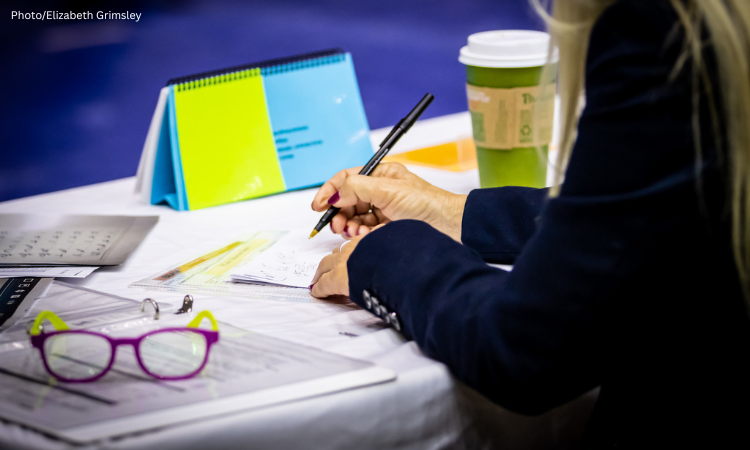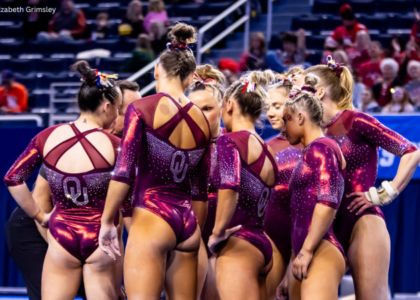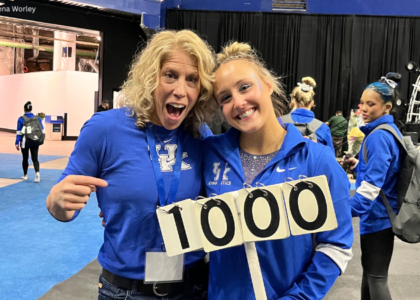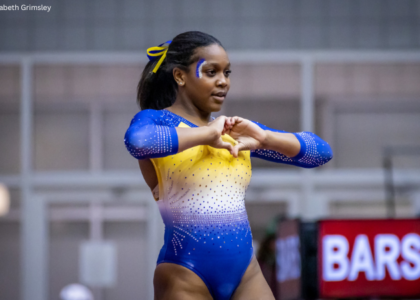We’ve all seen some controversial routines with lively debates about what the score should have been. On the judging side, few routines are more controversial than the 9.850/10.000 split. One judge thinks the routine was perfect while the other sees the routine as…pretty significantly less perfect.
Judges’ scores have to be within a two-tenth range on any average score over a 9.500, which seems reasonable enough until you get a 9.800/10.000 split, which for top teams is often more than the difference between the top and bottom score in an entire lineup.
With gymnastics being a subjectively evaluated sport, as well as the fact that judges have different perspectives of the routines, some variation is expected. If the variation is greater than two tenths, the judges can call a conference and discuss their deductions. But when a 10.000 and a 9.850 or even a 9.800 are flashed from the judging tables, everyone wants to know what the other judge was thinking, including the judges themselves. Without the ability to call a conference and the NCAA’s insistence on independent scoring from judges, there’s nothing to do but let the scores stand.
This week, we’ll be looking at some of these routines to see why there might have been such a large difference in opinion. Interestingly, all of these splits have been on either beam or floor.
Beam
Amber Koeth (Sacramento State)
Amber Koeth scored the first 10.000 from any judge on beam for a Sacramento State gymnast, and I can see why. Looking at this routine! She flexes her front foot early in each of her back tumbling skills, which in total would be a two-tenth deduction. However, judges usually take quarter tenths or none at all for flexed feet. She does a beautiful ring jump and hits the position so quickly it almost looks incorrect, but as you can see from the picture above, her back foot is at head height with full head release and a 180-degree split, which would incur no deduction. So perhaps the 10.000 judge ignored the flexed feet and the 9.850 judge took the feet and/or the ring jump positioning (however unjustly). If you’re ignoring flexed feet like most NCAA judges, then a 10.000 is understandable here, and if you’re judging by the book, I can also see how you could score a 9.850. A 9.925 feels about right for this routine.
Rachel Rybicki (Alabama)
Rybicki hit this beam routine, but there were some issues with her form and her dance pass, as well as a clear arm swing on her dismount that puts me strongly on team 9.800 (or lower) rather than team 10.000 for this routine. She has some bent arms on her back handspring and flexed feet in her layout, but those deductions are often overlooked. Her cat leap to switch side quarter connection was broken, and she only completed the switch side (D), not the E skill it appears she intended.
If you watch her leg out of her cat leap, it drops and then lifts up again to step forward into the leap, breaking the connection. For her switch side leap, you can see her feet land sideways on the beam and then adjust on the beam to complete the final quarter. If you both break the connection and devalue her leap (which I did judging in real time), she easily could (and should) have started from a 9.900 for this routine.
On her dismount, she is clearly falling back on her heels and uses the arm swing to maintain her balance forward and avoid taking a step. In the background it sort of looks like one judge looked away while Rachel was starting to swing her arms, so maybe he didn’t see the arm swing?
Floor
Adeline Kenlin (Iowa)
Adeline Kenlin has great choreography and artistry in this routine, but I spotted a couple execution errors. She has some leg form in both her front double full and back one and a half, and her ring position is questionable enough to be deducted, if not downgraded. In order to be considered a ring leap position, her head needs to be back so that her chin is vertical, otherwise it is credited as a split jump with alternative leg positioning. At best, she should have gotten a deduction for her position. At worst, they could have downgraded her jump from a D to a C, which would have given her a 9.800 start value and a one-tenth compositional deduction. With the leg form plus the ring positioning, this felt like more of a 9.850 or lower routine to me than a 10.000.
Frankie Price (Arkansas)
Price opens her routine with a gorgeous double layout and does a great job keeping her body straight, even on her landing. She does have a small hop in place on her landing though, as well as a small slide of her front foot after a large lunge backward on her final double pike. However, we’ve seen routines go 10.000 before despite similar small errors. As you know, I’m a stickler for dance passes, and Price does the very popular switch side to straddle full that in reality is a switch side quarter, straddle three quarter, which is a deduction. Some of the 10.000 breakdowns I’ve done this month on floor have had the same errors, so I can see why a judge would go 10.000 on this routine, as well as how you can easily justify a 9.850.
Mati Waligora (Alabama)
Waligora opens with a difficult front layout to front double full but doesn’t quite control her landing, making her step sideways, which would not be considered a controlled step in the direction of her tumbling pass and would incur a deduction.
Her leap combination looks great, but the landing on her last pass is a little awkward. She seems to hop forward a bit and then step through. I could see how the judge on the other side of the floor might miss both of these deductions, especially if both landings were in the corners farthest from their view but in clear view of the 9.850 judge.
Emma Malabuyo (UCLA)
To probably everyone’s surprise (including my own), I’m much more on team 10.000 than team 9.850. I absolutely loved this routine, choreography, and delivery. Malabuyo’s dance pass is a beautiful display of her flexibility. She has a tiny foot adjustment on her first pass that I had to watch several times before I noticed it. In her last pass, she takes a large step backward, but her front foot doesn’t move; while not 100% controlled, it’s not a deduction most NCAA judges would take. She has some flexed feet in her round-offs that I noticed, but so have others who have consistently scored 9.950-plus on floor. If this were a 10.000 routine, I’d give it four stars, so I’m not actually sure where the 9.850 is coming from.
In the future, I’d love to see a change in the range of scores so that if the average score is greater than a 9.900, the maximum range of scores would be one tenth. With this change, the largest split you could have with a 10.000 is a 10.000/9.900, which seems much more reasonable. I think it would also decrease the number of 9.900-plus scores that we see in a season in general, reserving them for when the athletes are truly almost perfect. But for now, we will likely continue to see these large splits, especially on events like floor where the view of the judge can vary pretty significantly and cause differences in opinion.
READ THIS NEXT: Judge’s Inquiry: Breaking Down February’s Perfect 10s Part 1
Article by Rhiannon Franck
Rhiannon Franck is a former national-rated NAWGJ women’s gymnastics judge with over 15 years of USAG judging experience and nine seasons judging NCAA gymnastics. Outside of gymnastics, Franck works at a university as a nursing professor and loves to travel. You can follow her on Instagram and Twitter.
Like what you see? Consider donating to support our efforts throughout the year! [wpedon id=”13158″]





One comment
Comments are closed.